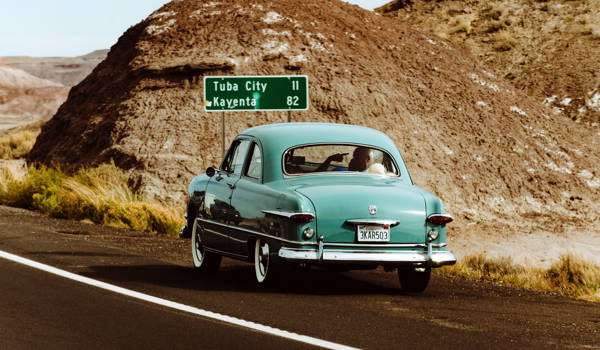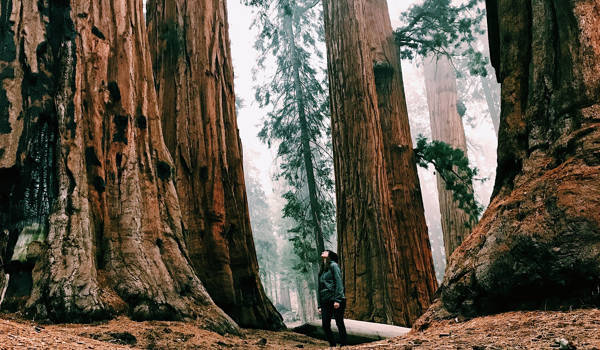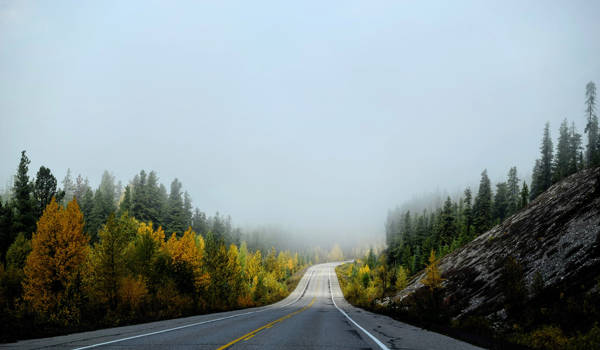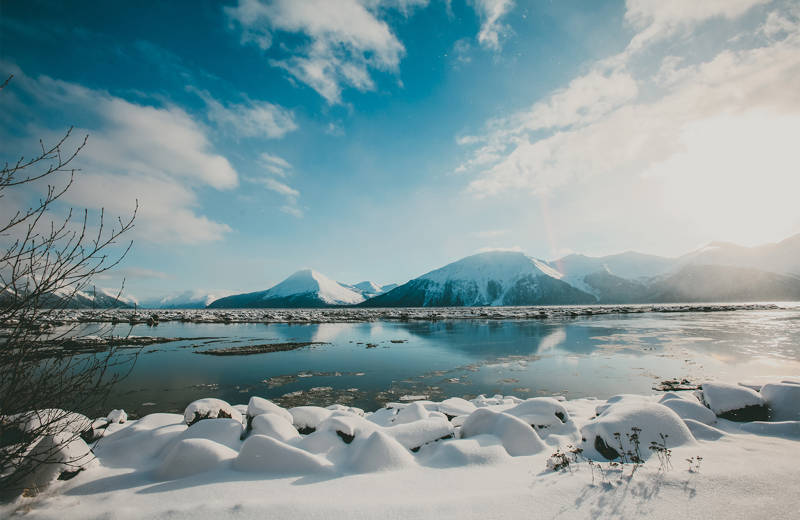All of our best tips and tricks for an amazing road trip adventure in North America
A road trip is never a bad idea. If you're planning a big adventure through the USA or Canada you have plenty of reasons to get excited, but there's also a lot to think about and plenty of tips and tricks to be found. In this article, we'll go over the best recommendations when it comes to road tripping in North America so you'll start your journey prepared.

On the road in the USA
The United States is the ultimate road trip country. Miles and miles of empty roads, iconic sights and national parks aplenty: we are absolutely sure you won't be bored.
On any road trip (not just in the US), make sure to make lots of stops. It helps with driving long distances, but we also just know your route is guaranteed to provide photographic opportunities along the way. Get those road trip memories for later!
Safety first!
When you're travelling to a different part of the world, different rules might apply when it comes to renting a vehicle. We strongly recommend that you read the terms and conditions of the rental contract thoroughly, so you know what's allowed and how you are covered.
In addition, we can't recommend enough that you have your travel insurance ready before the day of departure. If you don't have travel insurance, be sure to get in touch with one of our travel consultants who can help you out. It's a small cost, but a huge contributor to your peace of mind especially when driving thousands of kilometres.
Our very best road trip tips, straight from the experts
When asking our travel advisors for recommendations, there's a never-ending fountain of wisdom and advice coming your way. In this article, we've tried to streamline a lot of our best tips and tricks so your road-trip adventure will be a great success. Let's get right to it...


National Parks, Monuments and Historic Sites
The entire point of a road trip is to visit a lot of places along the way, right? In both the USA and Canada this probably means you'll be visiting plenty of national parks. Lucky for you, there are some great savings to be found here.
In the USA you will be able to buy an annual pass to get access to more than 59 National Parks to visit. You'll save money on entry fees and best of all: it also works for other monuments and historic sites. It's best to buy this pass in advance. You can even scout travel forums/groups for a ''secondhand'' one, as they are valid for an entire year and aren't bound to one person.
For Canada, there is no all-in-one pass, but you can buy a Discovery Pass which will help you save quite a bit on entry fees with discounts and other perks.
Tip 1: The perfect driving distance
Ever wondered about distances and how many kilometres you should plan for on a road trip? The golden rule is about 180 kilometres per day in total. If you plan a 17-day tour to California, your road trip should not be more than 17 x 180 = 3060 km. This includes days with no driving at all. Trust us, the rule works!
Tip 2: Fill your tank outside the big cities
Though a lot cheaper than at home, gas prices in the States and Canada are no longer as cheap as they used to be. You will do wise in tanking up outside the big cities. Gas prices can often be as much as a dollar cheaper (per gallon, that's 3,75 liters) if you avoid big cities like L.A., San Fran, San Diego, Chicago etc. An average rental car will do 10-12 km/per liter, and less if the airconditioning is on.
Tip 3: Overnight parking costs
Try to avoid parking your car overnight in the downtown area of major cities. It will cost between USD 20-50 per night around downtown hotels in cities like San Francisco, L.A., New York and Washington. Instead, find accommodation with parking included or stay overnight just outside the city. A lot cheaper, but close enough to have your morning breakfast at Denny's downtown.
Tip 4: Saving on a cross-country car rental
If you want to drive from coast to coast, we recommend driving from West to East (California to New York City area). It's the cheaper option but no less fun! The reason for the price difference is that any car rental starting in California is quite a bit cheaper than starting on the East Coast.


On the road in Canada
Driving in Canada is pretty similar to the USA, with wide open roads outside the big cities. It's a very relaxing country to drive through, especially in the summertime.
When winter hits, it's slightly more tricky since snow and ice can make a big impact on how your rental car handles. If you're not used to driving in wintery conditions it's best to go during summer and avoid any nasty vacation-ruining surprises.
If you're heading to Montreal Island (at any time of the year), spend a little time looking up the incredible random driving rules there. It will give you a laugh, while also making sure you're prepared for your visit.
Tip 5: Driving the California Highway 101
If you are going to California there's a good chance you're planning on driving the scenic coastal highway 101. Yes. it definitely lives up to the hype (as long as you make plenty of stops in the charming coastal towns), but be sure to tackle it in the southern direction, from San Francisco to Los Angeles. If you do it the other way (from south to north), you will be driving on the mountainside of the road, and not on the ocean side. This means you lose out on the scenic views and easy access to viewpoints. When you drive it from North to South, pretty much everything you want to see and do is on the right side of the road!
Bonus tip: Always check road conditions before driving California route 101 - road closures are frequent due to landslides after heavy rain.
Tip 6: Seasonality – Yosemite National Park
The Tioga Pass in Yosemite National Park is normally closed from late October to mid-May due to the weather conditions in winter. If you need to pass the Sierra Nevadas outside of the main season you either have to drive south via Bakersfield (on the side of Sequoia National Forest) or north via the city of Reno to cross the impressive mountain range. This will take you a bit longer, but at least the views make up for it!
Tip 7: Save pennies for the toll roads
Plenty of US states have toll roads. Toll roads are often faster than regular highways, especially around major cities, but they will cost you a few bucks. Remember to save your coins as some toll plazas do not accept credit cards (though increasingly less common). If you do not pay on location, the fee will be registered on the license plate of the rental car and it will be charged to your credit card by the rental car company afterwards, plus an extra administration fee.

Tip 8: Get a GPS (and an old-fashioned road atlas)
A GPS is like magic. Without one, prepare to get lost. As much as it could be fun to get lost, it’s honestly more fun to actually get where you’re going. You have several options when it comes to a GPS.
- You can rent one with the car
- Bring your own from home (make sure you have installed USA/Canada map)
- Buy one at Wallmart upon arrival
- Use Google Maps on your phone (download "offline areas" before you go or get a local SIM card with a USA/Canada data plan)
No matter what you prefer, having a GPS is incredibly valuable. However, the classic Rand McNally Road Atlas is an excellent addition for planning and getting an overview of your road trip.
Not a fan of books and paper? The excellent smartphone app MAPS.me has very detailed (and free!) maps you can download offline and use when off the grid. They often show even the smallest walking paths, and it hasn't let us down so far. You can even use it to navigate with multiple stops, as well as mark favourite locations and waypoints.
Tip 9: Get a cooler for your road trip
For USD 15-20 you will get a decent cooler and can enjoy cold drinks and snacks on the road. This one is a winner! Also, get a few ice packs or make your own; most hotels have an ice cube machine. Bring zip-lock bags and fill them up. Simple and free. Not cold enough? Pack your cooler with some dry ice, which you can easily get at most Costco's, Walmart's and even gas stations and 7-11' locations. It's a cheap and effective way of keeping your drinks and snacks cool all day, even when your car is parked in the blazing hot sun of Death Valley.
If you're renting a campervan or motorhome, rest assured that these types of vehicles already come equipped with a fridge or cooler.
Tip 10: Bring an extra credit card
When renting a car, please be aware that some North American rental locations do not accept debit cards or combined debit and credit cards. For any adventure abroad, we recommend an international credit card, simply because it will never let you down and it's an easy way to keep all your expenses in one place. Most cards also come with some type of (travel) insurance, so be sure to compare the terms between the different options if you don't have a credit card yet.

Tip 11: Read the rental agreement
We know, it is so boring! But it's time well spent to thoroughly read the terms and conditions of your rental agreement before signing it. Car rental companies can be quite aggressive in trying to sell extra products, insurance or upgrades. So make sure not to sign for add-ons you haven't asked for as you won't be able to get it refunded afterwards.
Tip 12: Pre-book parts of your accommodation
This brings us back to setting up a road trip itinerary before you leave. Yes, a road trip is the epitome of freedom, but keep in mind that if you want to visit some of the stunning and incredible National Parks, you might have to pre-book accommodations or campgrounds in these popular locations.
Accommodation inside popular National Parks such as Yosemite, Yellowstone, Grand Canyon, Arches, Zion, and Bryce Canyon is likely to sell out up to 6 months ahead during the summer. If you’re in a campervan or motorhome, remember to pre-book your spot at your desired campsites as there can be big differences in location and facilities.
It's also nice to have these set waypoints in your driving route, with enough flexibility in between to maintain that freedom feeling and leave room for spontaneous adventure.
Tip 13: Mind the different driving rules
Most of the driving laws in North America make sense to us Europeans. There are a few standing out that you should know about to not be road raged by fellow drivers.
The right turn on a red light: In The USA and Canada it's generally allowed to turn right, even when the light is red. Beware of other traffic, of course, as they still have right of way over you if their light is green. There are a few local exceptions, so be sure to look up the local regulations on this beforehand. One notable exception is the island of Montreal in Canada. Here a red light means red, no matter in what direction you're turning.
Adding to that: if you're not turning right it's best to stay out of the outer-right lane at traffic lights, to give way to cars that want to turn right.
Be aware of school buses in the USA: It's remarkable how rigid traffic laws surrounding school buses are in the states. When a school bus stops along the road to pick up or drop off passengers, all traffic must come to a halt. Most American school buses have pop-out signs and flashing red lights to make you aware of this, but what many don't realise is that it also counts for traffic coming the other way (unless there's separate lanes). Penalties are pretty serious, so if in doubt just make sure to stop your car. Good thing these buses are bright yellow, so you can't miss them!
Be sure to read up on the traffic laws and regulations in the states you'll be passing through before starting your journey. We wouldn't want a traffic fine to blow a huge gap in your travel budget right?
Oh, and don't forget to avoid driving blindfolded in the state of Alabama. It leaves us wondering how that law ever came to be...


